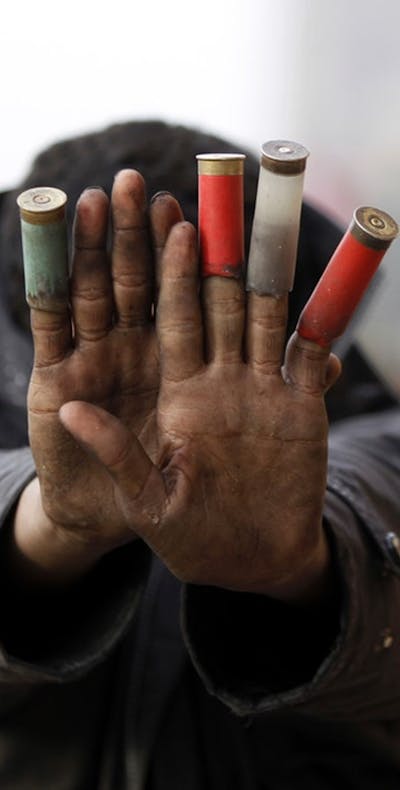
Amnesty International releases 25 rules to curb the misuse of kinetic impact projectiles
Responding to the frequent misuse across the globe of kinetic impact projectiles, commonly known as rubber bullets, Amnesty International has published a new briefing setting out how and when these weapons can be deployed in accordance with international human rights law, highlighting the guiding principles of legality, necessity, proportionality, non-discrimination and accountability. The rules are intended to guide governments and law enforcement agencies in developing human rights-compliant laws and policies for the use of kinetic impact projectiles and to stop and prevent the dangerous misuse of these weapons.
“Time and again, law enforcement officials are too quick to resort to using force, often against protesters exercising their rights to freedom of peaceful assembly, causing serious injury and even death. Rubber bullets are particularly dangerous weapons and frequently cause tragic injuries, such as loss of eyesight, and even death,” said Dr. Anja Bienert, Amnesty International’s police and human rights expert.
“Police may only use these weapons in exceptional circumstances when there is a considerable risk to other persons. And they may only be used as a last resort when no other, less harmful and less risky means are available to stop the threat. These 25 rules should guide law enforcement officials in when they can and cannot use rubber bullets and how they should use them.”
Firing kinetic impact projectiles at peaceful protesters, random firing at a crowd, firing of multiple projectiles and other highly inaccurate projectiles – these are just some of the misuses Amnesty International has reported on for instance in Chile, Colombia, France, India, Iran, Israel, Spain, and Thailand, to name just a few contexts where dozens or sometimes even hundreds of people were seriously injured, many of them permanently losing eyesight.
“The partial loss of sight of young Gareth Sella and Leidy Cadena due to the impact of a kinetic projectile are clear examples of the inappropriate and improper use of kinetic impact projectiles by the National Police when intervening in protests in Colombia, causing serious injuries and affecting the lives of young people and peaceful demonstrators. It is urgent for the National Police in Colombia – as well as for law enforcement agencies in many other countries around the world – to bring its actions into line with international human rights standards and use kinetic impact projectiles only in exceptional situations, when duly justified and in a careful manner that avoids excessive harm,” said Dr. Bienert.
Just recently, police fired rubber bullets indiscriminately at peaceful protesters who gathered for an International Women’s Day event in Basel in Switzerland on 8 March – illustrating the global scale of the rampant misuse of this weapon.


Kinetic Impact Projectiles (KIPs) are distinct from “live ammunition” and are supposed to only cause blunt trauma from impact, but they can still inflict serious injury or even cause death. © Sérgio Silva

KIPs should never be used to disperse an assembly or fired randomly at a crowd. © Jack TAYLOR/AFP (photo of Jack TAYLOR/AFP via Getty Images)

Police should never use KIPs against people who are peaceful and/or only passively resisting or running away. © Zakaria ABDELKAFI/AFP

KIPs should not be used against younger and/or smaller children or persons with smaller stature and thinner body tissue. © Private

KIPs should only be aimed at the lower parts of the person’s and never at the upper part, especially head, face or eyes. © Mídia Ninja

The use of multiple projectiles should be prohibited due to their inaccuracy and risks to hit not only the targeted person and the targeted area of the body but also other persons nearby and other parts of the body such as the eyes. © Amnesty International

Clear international standards
Amnesty International’s briefing is accompanied by 25 rules on how to use kinetic impact projectiles in a human rights-compliant manner. These are based on the UN Basic Principles on the Use of Force and Firearms by Law Enforcement Officials, as well as Amnesty’s 2015 Guidelines on how the Basic Principles should be implemented.
In particular, law enforcement officials should:
✔ Only use KIPs to stop an act of serious violence against another person likely to cause considerable harm.
✔ Only use KIPs as a last resort when there is no less harmful alternative available.
✔ Warn people of the intention to use KIPs and give them sufficient time to comply with the order.
✔ When using, target less vulnerable parts of the body (lower torso and limbs) and avoid the upper body, head and groin.
✔ Be able to justify every use of KIPs.
Law enforcement officials should never:
❌ Use KIPs against people who are peaceful and/or only passively resisting or running away.
❌ Use KIPs as a means of dispersal.
❌ Fire KIPs randomly at a crowd.
❌ Aim at the upper part of the body.
❌ Use multiple projectiles.
For more information or to arrange an interview, please contact the Police and Human Rights Programme: phrp@amnesty.nl
Read more:
Amnesty International Position paper:
https://www.amnesty.nl/content/uploads/2023/03/Amnesty-position-paper-kinetic-impact-projectiles.pdf
(Research, 2 March 2023)
25 Rules on the use of kinetic impact projectiles in law enforcement:
https://www.amnesty.nl/content/uploads/2023/03/Leaflet-KIP-English-online.pdf
(Research, 2 March 2023)
Press-release:



